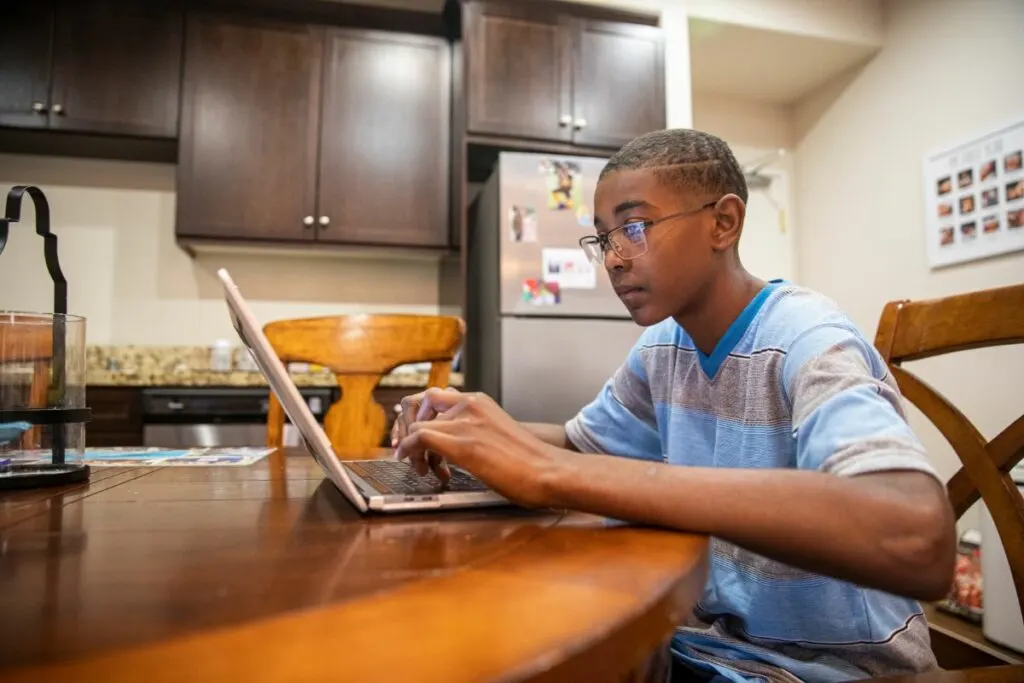In the dynamic realm of education, parents continually seek alternatives to meet their children’s unique needs.
While researching the alternatives to traditional schooling, some parents wonder whether you can do half homeschool and public school.

In order to try and provide a definitive answer, we dived into the intriguing hybrid approach, often known as flexi-schooling, in order to scrutinize the challenges and rewards that it presents.
Hybrid Schooling
Hybrid schooling is a nuanced blend of traditional public school and homeschooling, and it offers both the structured environment of public schools and the inherent flexibility of homeschooling.
This model allows families to adapt to the diverse needs of their children by offering a complete, personalized educational experience.
In practice, hybrid schooling involves a strategic combination of public school attendance and homeschooling, allowing students to benefit from the structure and resources of traditional schooling while enjoying the flexibility and customization of learning at home.
The Anatomy of a Hybrid Schooling Schedule
Undertaking a hybrid schedule necessitates adhering to a finely tuned schedule that maintains a balance between public school hours and dedicated homeschooling time and demands careful planning.
The schedule becomes the backbone of each day, ensuring both educational facets receive the requisite attention, and adapting to it can take time.
To establish an effective hybrid schooling schedule, families must consider the curriculum requirements of the public school, allowing dedicated time for homework and assignments while simultaneously allocating specific periods for homeschooling activities and embracing a more personalized and in-depth exploration of subjects that aligns with the child’s interests and learning pace.
The Flexibility Advantage Of Hybrid Schooling
Flexibility is a cornerstone of homeschooling, and seamlessly intertwining it with the rigid structure of public schooling in the hybrid model can be difficult.
That said, it does allow families to cater to a child’s individual learning pace and style while adhering to the curriculum standards set by the public school system.
The flexibility advantage extends beyond scheduling, as in hybrid schooling, students can explore topics of personal interest in more depth, engage in hands-on learning experiences, and pursue projects that align with their passions, and this nurtures a love for learning while encouraging students to take ownership of their own education.
Curriculum Tailoring In Hybrid Schooling
A significant revelation is the ability to tailor the curriculum to fit the child’s needs, and hybrid schooling empowers parents to supplement and enrich the public school curriculum, addressing specific interests or potential gaps.
This customization ensures that a child’s education aligns with their passions and strengths, which helps to promote a more robust learning experience.
In the context of curriculum tailoring, parents may choose to integrate additional educational resources, such as online courses, extracurricular activities, or specialized tutors, to enhance the child’s understanding of certain subjects, and this hybrid approach enables students to delve into areas of particular interest, fostering a well-rounded and comprehensive education.
Socialization Dynamics: The Hybrid Schooling Nexus
Hybrid schooling does, however, create unique socialization dynamics, as children attending public schools engage with diverse peers, which creates a unique set of social skills, while homeschooling nurtures close-knit family bonds, creating well-rounded individuals.
Striking an effective balance between the two contributes to the development of social intelligence and adaptability.
Socialization in hybrid schooling extends beyond traditional classroom interactions as public school attendance allows students to navigate diverse social environments, aiding the development of interpersonal skills, teamwork, and cultural awareness, while homeschooling provides opportunities for one-on-one interactions within the family, promoting strong familial bonds and individualized attention.
Personalized Learning: The Hybrid Advantage
Hybrid schooling caters to personalized learning experiences, and by leveraging the strengths of both systems, children can receive individualized attention, allowing them to explore topics of interest more deeply and at their own pace.
This individualized approach ensures that students can develop a genuine passion for learning, leading to better retention and academic success.
The personalized learning advantage of hybrid schooling is particularly evident in addressing diverse learning styles, as public schools typically follow a standardized approach, while homeschooling allows for flexible teaching methods.
In a hybrid model, parents can adapt their teaching strategies to match the child’s preferred learning style, whether visual, auditory, or kinesthetic, which creates a more effective and enjoyable learning experience.
Parental Involvement: A Pillar Of Hybrid Schooling
Active parental involvement is crucial in the success of hybrid schooling as parents act as facilitators, ensuring seamless communication between the two educational paradigms and providing consistent support.
In hybrid schooling, parents collaborate with public school teachers to understand curriculum requirements and track their child’s progress, and this collaboration ensures that the child receives the necessary support in both environments.
Simultaneously, parents take an active role in homeschooling, adapting teaching methods and providing additional resources to enhance the child’s learning experience and, at the same time, reinforce the public school curriculum.
Overcoming Challenges In Hybrid Schooling
Juggling two educational paradigms demands adaptability, and overcoming challenges such as scheduling conflicts and potential gaps in learning requires proactive solutions.
One of the key challenges in hybrid schooling is managing the transition between public school and homeschooling. Scheduling conflicts may arise, requiring careful planning to ensure a smooth flow between the two environments.
Additionally, addressing potential gaps in learning, especially when transitioning between different curricula, involves a proactive approach, such as supplementary tutoring or targeted educational resources.

Decision-Making Factors In Hybrid Schooling: A Holistic Perspective
The feasibility of a half-homeschool, half-public school approach hinges on individual needs and factors such as learning styles, socialization preferences, and the availability of parental support, all of which play pivotal roles in deciding whether hybrid schooling is a suitable fit.
A holistic perspective is essential in evaluating how the unique combination of homeschooling and public schooling aligns with the specific requirements and preferences of each family.
When making decisions about hybrid schooling, families consider the academic needs of the child, the family’s lifestyle, and the child’s learning preferences, and assessing the child’s socialization needs is equally crucial, as is evaluating the level of parental commitment required for successful implementation.
The decision-making process involves a careful weighing of these factors to ensure that hybrid schooling aligns with the overall goals and values of the family.
Real-World Applications Of Hybrid Schooling
Analyzing real-world applications sheds light on how hybrid schooling transcends theory, as examples where families successfully navigate the hybrid model offer insights into the adaptability and effectiveness of this educational approach, while real-world applications demonstrate the practicality of hybrid schooling, illustrating how it can be implemented successfully to cater to the diverse needs of students and families.
Real-world applications showcase the versatility of hybrid schooling in different family settings. Families may choose this approach for various reasons, such as accommodating a child’s special needs, providing a more flexible learning environment, or instilling a deeper connection with the curriculum.
The Role Of Technology In Hybrid Schooling
In the digital age, technology plays a crucial role in hybrid schooling, and the integration of technology in this educational model highlights the potential for innovative approaches to teaching, making learning more engaging and accessible.
Technology serves as a bridge between the public school and homeschooling components of hybrid education, and virtual classrooms facilitate remote learning experiences, which enables students to engage with public school lessons from the comfort of home.
Educational apps and online resources can provide additional tools for parents to supplement and enrich the curriculum as the role of technology in hybrid schooling extends beyond convenience; it opens up new possibilities for interactive and engaging learning experiences.
Hybrid Schooling vs. Homeschooling vs. Traditional Schooling: Comparing Educational Approaches
When choosing between hybrid schooling, homeschooling, and traditional schooling, each path presents distinct advantages and challenges, catering to diverse learning styles and family dynamics.
Hybrid Schooling: This innovative model merges the structure of traditional schooling with the flexibility of homeschooling, and hybrid schooling allows students to access the resources and social interactions of traditional classrooms while benefiting from the personalized attention and adaptability of homeschooling. It seeks to strike a delicate balance that offers tailored learning experiences and individualized attention.
Homeschooling: Under the homeschooling umbrella, parents take charge of their child’s education, designing a curriculum aligned with their values and the child’s learning style, and this approach creates a close-knit learning environment, allowing flexibility in pacing and depth of study. However, it places the responsibility of teaching squarely on parents, demanding a high level of commitment from them and expertise in various subjects and disciplines.
Traditional Schooling: The conventional path of traditional schooling provides a structured environment where students follow a standardized curriculum, and it offers exposure to diverse social settings and a range of extracurricular activities. While traditional schooling ensures a comprehensive education and socialization, it may sometimes lack the flexibility needed for individualized learning experiences.
Choosing among these approaches requires a thorough consideration of the child’s learning preferences, the family’s lifestyle, and educational goals.
Hybrid schooling attempts to harmonize the structured elements of traditional schooling with the adaptability of homeschooling, while homeschooling provides unparalleled customization, demanding a significant commitment, and traditional schooling offers a tried-and-tested path but may lack the personalization some families seek.
It’s a complex choice, demanding careful consideration of each option’s merits in the context of individual circumstances and educational goals.
Final Thoughts
Hybrid schooling involves meticulously blending the structured elements of public schooling with the flexible dynamics of homeschooling, and we found that this approach while demanding, has the potential to create a uniquely tailored educational experience.
Understanding the complexities and embracing the opportunities it offers means that families can unlock the doors to a holistic education that harnesses the strengths of homeschooling and public schooling while rejecting the less appealing aspects of both and embracing a system that truly works for the benefit of the students in its care.
You May Also Like: Homeschooling vs unschooling – understanding the differences.
- Homeschooling In High School: Pros And Cons - February 24, 2024
- How Do I Withdraw My Child From School To Homeschool? - February 23, 2024
- How To Not Go Crazy Homeschooling Kids: A Guide For Frazzled Parents - February 22, 2024









Leave a comment